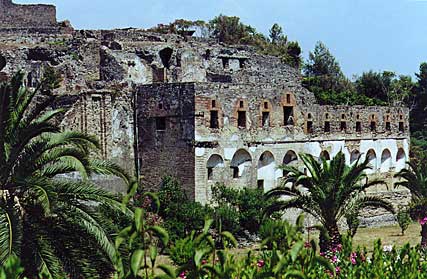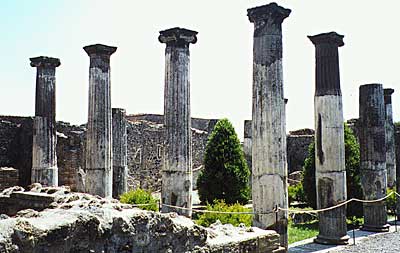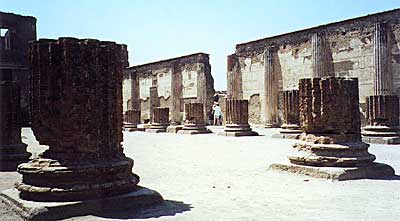
|


|
|
|
Mr. Sedivy's
|
Highlands Ranch High School - Mr. Sedivy
To date, about 80% of the ruins at Pompeii have been excavated and studied, giving us a picture of how the city was built and organized. Pompeii was surrounded by a three-kilometer wall containing eight gates.
The city of Pompeii had a population of 8,000 - 10,000 people, about 60% freemen and 40% slaves. House slaves came from the East and were almost always well-educated -- often more so than their owners. A small, prosperous family in Pompeii generally had two or three slaves; larger families had many more, including slaves that were doctors or teachers. A slave could be granted freedom by his owner or by paying a large sum of money, becoming a "freedman."
The Forum is located to the west with public buildings and temples grouped around it. The Large Theatre is to the south, and the Amphitheatre is located to the east.
About two-thirds of the walled city is occupied by private buildings including shops, offices, inns and houses. The area outside the city gates is the Necropolis or cemetery. The Port of Pompeii was originally located on the coast. The exact location of the port has not been identified, although several buildings have been discovered. Entrance to the Ruins and Roads of Pompeii - III Temples of Apollo, Isis, and Jupiter - V Water Supply and the Baths of Pompeii - VI Pompeii's Mills, Bakery, Laundry, and Brothel - VII Court of the Gladiators,
Amphitheatre, and
|
Highlands Ranch High School ![]() 9375 South Cresthill Lane
9375 South Cresthill Lane ![]() Highlands Ranch, Colorado 80126
Highlands Ranch, Colorado 80126 ![]() 303-471-7000
303-471-7000
Mr. Sedivy's History Classes
| Colorado History | American
Government | Modern European History | Advanced
Placement European History | Rise of England
| World History |
| Home | Back to the top of page
| Site Contents |





